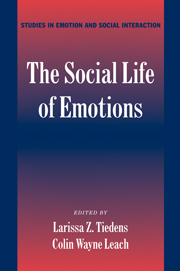Book contents
- Frontmatter
- Contents
- Acknowledgements
- List of Contributors
- The Social Life of Emotions
- Introduction: A World of Emotion
- PART I THE INTERPERSONAL CONTEXT
- 1 Empathy
- 2 Envy and Its Transmutations
- 3 The Bond Threat Sequence
- 4 Emotion as Adaptive Interpersonal Communication
- 5 Does Expressing Emotion Promote Well-Being? It Depends on Relationship Context
- PART II THE INTRAGROUP CONTEXT
- PART III THE INTERGROUP CONTEXT
- Index
- References
5 - Does Expressing Emotion Promote Well-Being? It Depends on Relationship Context
Published online by Cambridge University Press: 01 April 2011
- Frontmatter
- Contents
- Acknowledgements
- List of Contributors
- The Social Life of Emotions
- Introduction: A World of Emotion
- PART I THE INTERPERSONAL CONTEXT
- 1 Empathy
- 2 Envy and Its Transmutations
- 3 The Bond Threat Sequence
- 4 Emotion as Adaptive Interpersonal Communication
- 5 Does Expressing Emotion Promote Well-Being? It Depends on Relationship Context
- PART II THE INTRAGROUP CONTEXT
- PART III THE INTERGROUP CONTEXT
- Index
- References
Summary
Questions concerning whether it is best to express or suppress felt emotions have long been of interest to psychologists. Is expressing pride in one's accomplishments a good thing? It does allow others to celebrate one's accomplishments, but it can lead to one being judged as arrogant. Are fears best confided to others or should they be suppressed? Expressing fears may elicit help and comfort or derision and exploitation. What will happen if one expresses sadness? Will companions express compassion and reassurance or pity and avoidance? Most generally, is expressing one's emotions good or bad for your personal well-being?
Our answer to all of these questions is, “It depends.” To the extent that emotions carry information about one's needs, we argue, the wisdom of expressing them to others depends importantly, even crucially, on the relationship context within which one finds oneself. Our position is simple: Expressing emotion is likely to be beneficial in the company of others who care about one's welfare. The more companions care, the wiser expression of emotion is likely to be. Such expressions are more likely to be accepted, elicit care, and maintain or strengthen the caring relationship. In sharp contrast, if one finds oneself with companions who do not care about one's welfare, it is generally unwise to express emotions indicative of one's needs. At best, the expressions will be ignored; at worst, one may be avoided, derided, or exploited.
- Type
- Chapter
- Information
- The Social Life of Emotions , pp. 105 - 126Publisher: Cambridge University PressPrint publication year: 2004
References
- 18
- Cited by



